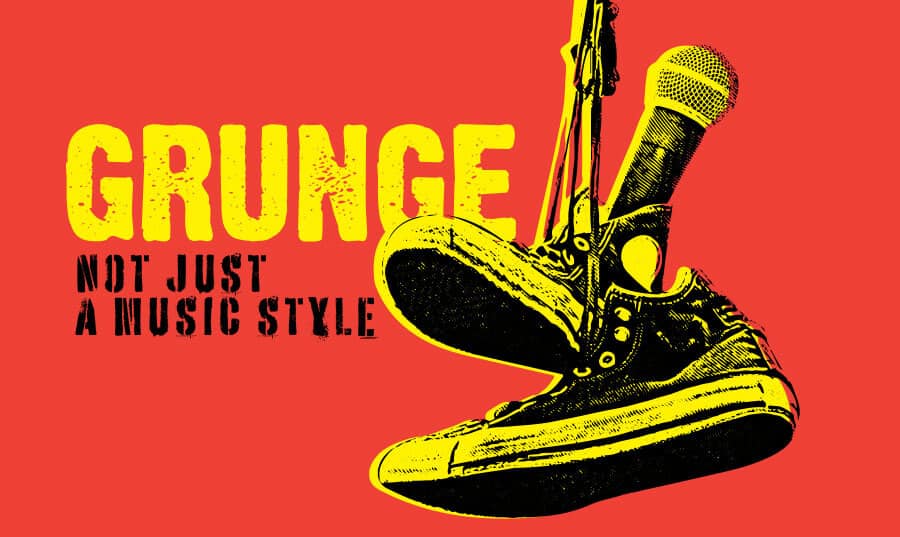If you talk to most individuals who were teenagers during the late’ 80s and ’90s, they will tell you that they lived through the golden age of grunge music. And not just grunge music itself, but the grunge style in general. You might notice a uniform look in these former teenagers, often wearing old, discolored t-shirts, baggy jeans, and Doc Martens. Those were the good times, they will say. But how much is Grunge really following the lives of the Millennials? Is it really as cool to be uncool nowadays?
First things first, what does Grunge even mean?
Well, for starters, Grunge music first emerged during the ‘80s in the U.S state of Washington – Seattle. That is why this style of music is also known as the Seattle sound. Most of the famous bands that were faithful to it were from Seattle.

Professor Catherine Strong, in her book ‘Grunge and Memory‘ writes that the term “grunge” was primarily related to unclean music sounds. She writes that it was expensive and time-consuming to get a recording to sound clean. For northwestern bands that just started out it was cheaper to leave the sound dirty and just turn up the volume. According to her, this dirty sound, due to low budgets, unfamiliarity with recording technology, and a lack of professionalism, may be the origin of the term “grunge.”
Yet, most grunge icons at the time refused to be identified by this term, some even considering it offensive. So, the definition was rather vague. However, you will certainly recognize grunge music in the songs of legendary bands such as Pearl Jam and Nirvana, or Soundgarden and Mudhoney.
Grunge was considered real and authentic
The level of relatability you could experience while listening to it. That was so unique about this emerging style of music. The lyrics were symbolic, heartfelt, and filled with an anger. It dwelt and elaborated on the so-called dread of existentialist crisis.

These were the people who were singing about social isolation, psychological trauma, and depression. At the same time they promoted a sense of freedom of expression. One can argue that some of the lyrics were rather nihilistic. Sometimes even suicidal, speaking of broken homes and drugs, inciting people to discover new dimensions. But when all is said it was the reality that most of these people were living in. Grunge was considered real and authentic.
It was no surprise that grunge bands spoke to the hearts of such an immense audience. Grunge had just the right amount of everything. The right amount of frustration, emotions, and guitar distortion, taking a little bit from metal bands such as Black Sabbath or AC/DC . But also picking up elements of punk rock, making for a wonderful hybrid.
Sooner than imagined, Grunge was spreading all around the United States and Australia. The major success that it experienced, specifically during the ‘90s, relates to the famous releases. Some of the most historic albums were Nirvana’s “Nevermind” album, Pearl Jam’s “Ten”, Soundgarden’s “Badmotorfinger”, or Alice in Chains’s “Dirt”.
But is Grunge dead?
This must be one of the most common questions you encounter in the music industry. There are so many respondents who will give you different perspectives on the death (or not) of Grunge. Most of them will surely tell you that this troublesome genre ended with the death of the just as troublesome persona, Kurt Cobain. This month of April even marks the 26th anniversary of his death. People remember that April day as one of the most tragic moments in the history of rock music. There was so much relevance in Kurt’s lifestyle, and in what he preached through his songs, that people’s hearts were torn to pieces to see that he was defeated.
However, was Nirvana all the Grunge there was? Because there were so many other bands, including bands that did not sound like Nirvana did, but that were just as authentic. What about Soundgarden (say, if their band had stuck together), Pearl Jam, Mudhoney, or Alice in Chains?
History shows us that this genre has witnessed much high-profile tragedy in a short period of time. Some even joke about it, saying that Grunge must have been cursed, considering some of the events that took place, explained by Loudersound. They elaborate on the deaths of some of the most famous grunge band icons, like some sort of prophecy that it was all expected to happen, with each front man being pursued by the same fate.
They reminisce about the fact that both Cobain and Alice in Chains’s front man Layne Staley died alone and in agony in 1994 and 2002. The cycle continues with Soundgarden’s Chris Cornell, who retreated into an introspective, drug-induced haze to hide from his photogenic appeal. Pearl Jam’s Eddie Vedder also couldn’t deal with his elevation to rock stardom.
So much more than a music style
It seemed like every other band that came along after the ‘90s would be considered corny, unoriginal. It reduced to copying the magic of the amazing bands that punctuated grunge history. Nothing was considered the same anymore. So yet again, is Grunge dead?
An alternative opinion is that the answer to that question should be a matter of what you consider Grunge to be. We mentioned earlier that Grunge is now considered so much more than just a music style. Somehow, along the way, it morphed into a movement that spoke out about so many social distortions. It represented generations and voices that had not been heard. It shouted in the ears of people who just simply would not listen.
In the same article about Loudersound, the author Malcolm Dome recalls one of Eddie Vedder’s statements regarding what we consider to be a movement now and the reaction of people towards it.
“I was shocked how many people related to Pearl Jam,” Vedder says. “It’s just so fuckin’ weird. You write about this shit, and you’re suddenly the spokesman for a generation. Any generation that would pick Kurt or me as spokesman, that must be a pretty fucked-up generation.”
Grunge is dead until we start giving new bands a chance
Whether as a music genre or a movement, Grunge continues to shape some of most Millennials’ lives. Those born after ‘85 and into the ‘90s, more than the others. It seems like most of the generations that came into this world after that would be the prey of commercial and corporate techniques. They would forever change the values worshipped in the music industry. The topics and lyrics would no longer be social. Heartbreak and romance would arise, with some glittery sparks of pop that would aim to enchant the teens of the late ‘90s (Cough, Britney Spears, NSYNC, etc.). But little did they know that they would hit the pre-teens with greatest impact.
We can conclude that Grunge is dead at least until we start giving new bands a chance without calling them out as unoriginal. Or maybe, we can leave it out as a style that belonged to those hectic times of the late ‘80s – early ‘90s.
But in terms of Grunge being a movement and a later lifestyle, we can pretty much say that Grunge is still everywhere. Specifically, in the lives of Millennials who are still experiencing the same exact existential dread as the grunge worshiped icons. And the dread doesn’t seem to be going anywhere!
Photos: Shutterstock, Panos Sakalakis, Pexels / edit: Martina Advaney
Support us!
All your donations will be used to pay the magazine’s journalists and to support the ongoing costs of maintaining the site.
Share this post
Interested in co-operating with us?
We are open to co-operation from writers and businesses alike. You can reach us on our email at [email protected]/[email protected] and we will get back to you as quick as we can.









